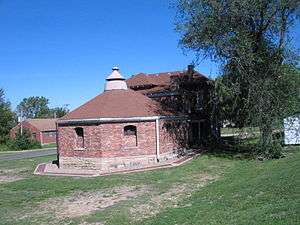Rotary jail

A Rotary jail was an architectural design for some prisons in the US Midwest during the late 19th century. Cells in the jails were arranged so that they rotated in a carousel fashion; allowing only one cell at a time to be accessible from the single opening per level.
Design and patent
The rotary jail was initially designed by architect William H. Brown, and built by the Haugh, Ketcham & Co. iron foundry in the Indianapolis, Indiana neighborhood of Haughville.

The application for United States Patent No. 244,358, on July 12, 1881 has this description:
- The object of our inventions is to produce a jail in which prisoners can be controlled without the necessity of personal contact between them and the jailer or guard... it consists, first, of a circular cell structure of considerable size (inside the usual prison building) divided into several cells capable of being rotated, surrounded by a grating in close proximity thereto, which has only such number of openings (usually one) as is necessary for the convenient handling of prisoners.
Features

The pie-shaped cells rotated around a core having a sanitary plumbing system, which was considered an unusual luxury at that time. The cell block could be rotated by a single man hand-rotating a crank. It was connected to gears beneath the structure which rotated the entire cell block. The structure was supported by a ball bearing surface to allow for smooth rotation.
Condemned
The jails encountered problems almost immediately with inmates' limbs being crushed or interfering with the cellblock's rotation. Most of the jails had to be welded in a fixed position and refitted with individual cell accesses. All of them, except for one, were condemned by June 22, 1939. The Pottawattamie County Jail in Council Bluffs, IA remained in use until 1969.
Locations
Sources vary as to how many rotary jails had been built. The cited number varies from six to eighteen. Below are eight known rotary jail locations:
Structures still standing (although turned into museums and now listed on the National Register of Historic Places):
- Montgomery County Jail and Sheriff's Residence, Crawfordsville, Montgomery County, Indiana
- This is the only one to still operate.[1]
- Council Bluffs, Pottawattamie County, Iowa,
- Gallatin, Daviess County, Missouri
- Sherman, Grayson County, Texas
Jails torn down:
- Maryville, Nodaway County, Missouri
- Paducah, McCracken County, Kentucky
- Maysville, DeKalb County, Missouri
- Salt Lake City, Salt Lake County, Utah
- Pueblo, Pueblo County, Colorado
References
External links
- Ben L. Ross architects
- Ben L. Loss History of the Jail
- Pottawattamie County Jail
- Indiana Statelib Publication 7028
- Patent on the rotary jail
- Article about rotary jails on 99% Invisible.com